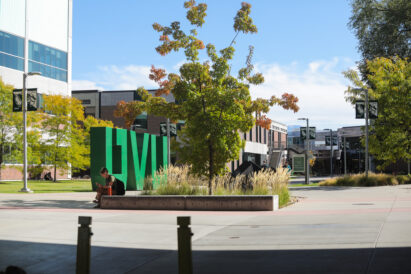LDS Church and United Nations discuss partnership in worldwide effort providing food assistance
David Beesley, executive director of the United Nations World Food Programme, would like to be put out of business by 2030.
But first, partners like The Church of Jesus Christ of Latter-day Saints must continue to step up the pace in a world where natural and man-made disasters are competing for lives.
“I have an exit strategy to put the food programme out of business,” Beesley said.
Beesley was in Salt Lake City on Monday to tour the LDS Church’s Welfare Square, Bishop’s Storehouse and Temple Square, and to meet with the staff of LDS Charities.
The church has partnered with the World Food Programme for the past six years and is looking at ways that partnership can grow and flourish in areas of the world in the greatest need.
Sister Sharon Eubank, president of LDS Charities and first counselor in the Relief Society General Presidency, said when partnering with organizations like the UN, the church must be very careful that red tape and bureaucracy don’t get in the way of actually caring for the needs of children, families and individuals throughout the world.
Eubank said there are two reasons why the partnership is so important. It gives the church a presence where there are no members of the faith, and where the church does have members, there is access to help through humanitarian aid, missionaries, members and more.
“(The church) is one of the largest non-governmental partners we have,” Beesley said.
Bishop W. Christopher Waddell, second counselor in the Presiding Bishopric of the church, said that as a church of 16-17 million members, it still is not that big of an organization on a global level and resources to help are limited.
“What we provide reaches out further (with the partnership),” Waddell said.
Eubank added, “When you have a good partnership you want to build on it.”
The three had further discussions on where the needs are and how to address growing problems.
All are concerned about climate change and how it is affecting places already hit hard by drought or flooding. Right now, the food programme has 86.7 million beneficiaries in 83 countries. About 52% of those receiving food assistance are women and girls.
Beesley said the Sahara Desert is moving 1 kilometer a year. The animals that graze are having to move and the only place to go is where the farmers are farming. That has caused great tensions and has allowed groups like Isis and Al-Qaida and others to move in.
The growing seasons are hotter and the other times of year colder. The heat makes it necessary to change the kinds of crops farmers are growing, which is difficult for them to change eating habits. Then, they have to find the markets that will buy so they can make money.
Beesley is seeking ways to help rehabilitate land so local farmers and families will be able to grow their own food. This also keeps them in their own countries without worrying about migrating.
More than half a million acres of land have been rehabilitated so far, but there is much more to be done.
The LDS Church is hoping to help with that effort. Beesley said he had no idea how much farmland the church owned and the methods in which it keeps the lands producing.
“Africa could feed the world,” Beesley said. “But we are feeding it.”
In Syria, it costs only 30 cents a meal. But if they migrated to say Germany it cost several euros. The programme and the church want to feed people where they live, rather than where they migrate to where it typically costs far more.
Beesley said he wants to end migration by giving people food security.
“Then it will be migration by choice,” Beesley said. He adds the migration numbers would be much less.
Beesley, Eubank and Waddell said their organizations want to move beyond just the emergencies of starvation and help mitigate what is causing those emergencies.
Here are some numbers from the WFP
– 5,000 trucks,20 ships and 92 planes on the move each day.
– 16.4 million children receive school meals in 60 countries.
– $7.2 billion raised in 2018 through 100% voluntary funding.
– 17,000 staff worldwide.
– 40 countries where WFP connects smallholders to markets.







